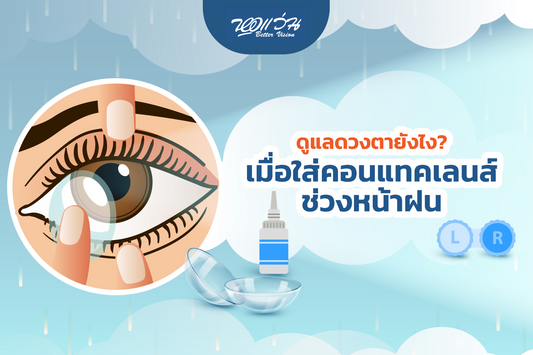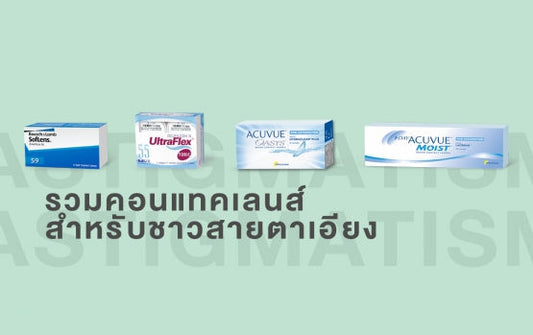Contact lenses are an alternative for those with nearsightedness, providing convenience, safety, and boosting confidence for those with vision problems.
However, wearing contact lenses is not as easy as it may seem, especially for those who have been wearing glasses for a long time and want to try contact lenses instead. Many people who are new to contact lenses often face problems when choosing which lenses to buy, where to start, which model to use, and how to put them on properly. Additionally, how to keep them clean is important, as improper care can lead to unexpected eye health issues.
In this article, Better Vision will share tips and the correct way to wear contact lenses for beginners, helping you use them safely, reduce the risk of infection, and take care of your eyes to keep them healthy.
12 Things You Should Know About Wearing Contact Lenses and the Correct Way to Put Them On
1. Eye Exam – A Crucial Step You Shouldn't Skip
The first step in wearing contact lenses is to get an eye exam to determine the correct prescription, so you can choose the right lenses for your vision needs. At Better Vision, our experts are available to take special care of your prescription, especially for those with astigmatism.
2. Contact Lens Prescription vs. Eyeglasses Prescription – They Are Not the Same
If you're switching from glasses to contact lenses, the prescription is not the same. Since contact lenses sit directly on the eye, the prescription needs to be adjusted to compensate for the distance between your eye and the lens of your glasses. This slight reduction in prescription ensures a comfortable fit. It’s recommended to consult with an expert to get the most suitable prescription for contact lenses.
3. What Type of Contact Lens Should Beginners Choose?
For beginners, daily disposable contact lenses are recommended as they are convenient and do not require cleaning. They also reduce the risk of infection. If daily lenses are not suitable, you can opt for bi-weekly or monthly lenses, which are easier to handle.
4. Is the Brand of Contact Lenses Reliable?
Before choosing contact lenses, ensure they come from a reputable brand and have clear certification, such as an FDA or similar standard. This ensures safety and quality.
5. Colored Contact Lenses – Should You Soak Them First?
When buying new colored contact lenses, they should be soaked in a contact lens solution for at least 4 hours or overnight before wearing them. This helps condition the lenses and prevents irritation from the solution.
6. Cleanliness Is Key
Since contact lenses directly touch your eyes, cleanliness is essential. Always wash your hands thoroughly before handling the lenses and dry them completely. Clean the lens case after each use and replace it every 3 months to avoid bacterial buildup.
7. Check the Shape of the Lens Before Putting It On
Contact lenses are designed to fit the curvature of your eye. Before wearing them, check the shape of the lens to ensure it's positioned correctly. The edge should curve inward, forming a circle, not outward. Also, ensure your eyes are healthy and not red, dry, or irritated before wearing lenses.
8. Clean Contact Lenses Properly
You should never use tap water to clean your contact lenses. Tap water may contain unseen contaminants. Always use a contact lens solution to clean the lenses and the lens case. Make sure to dry both your hands and lens case before touching the lenses.
9. Change the Solution Every Day to Extend Lens Life
You should change the contact lens solution every day. Reusing the solution can degrade its effectiveness. Using high-quality contact lens solution will ensure the lenses remain in good condition and prolong their lifespan.
10. Contact Lenses Have an Expiration Date
The lifespan of contact lenses begins from the first day they are used. For monthly lenses, they should be replaced after one month, even if they were not used every day. Daily lenses should not be worn for more than 8 hours at a time to prevent discomfort and irritation.
11. Remove Contact Lenses Before Eye Tests
As contact lenses change the shape of your cornea, remove them at least 1-2 hours before an eye exam so your cornea can return to its normal shape. Bring your lens case and solution to store the lenses while you get your eyes tested.
12. Consult an Expert Before Buying
Since your eyes are delicate, choosing the right brand of contact lenses is important. To ensure safety, consult with an ophthalmologist or an eye care expert before making your purchase.
Tips for Beginners to Wear Contact Lenses Like a Pro
Step 1:
Wash your hands with soap and dry them completely before handling contact lenses.
Step 2:
Take the contact lens out of the case, ensuring it has the correct shape. Use tweezers designed for contact lenses to handle them safely.
Step 3:
Place the contact lens on your clean, dry fingertip and gently apply it to your eye. The lens will suction to your eye by itself. Avoid touching other parts of the eye.
Step 4:
Blink gently to make sure the lens settles into place and sticks to your eye.
Simple Tips to Care for Your Eyes When Wearing Contact Lenses for Long Hours
For those who wear contact lenses for 8-12 hours a day, here are 3 simple tips to help:
1. Artificial Tears For dry eyes, artificial tears are essential.
Choose a daily-use option free of preservatives for long-term health, or a multiple-dose option for occasional dryness.
2. Remove Contact Lenses as Soon as You Get Home
Once you're home, wash your hands, remove your contact lenses, and switch to glasses to give your eyes a chance to rest and breathe.
3. Get Eye Health Checkups Twice a Year
It’s important to get your eyes checked regularly, especially if you have strong nearsightedness (greater than -5.00). Regular checkups will help prevent eye diseases.
Wearing contact lenses can be tricky for beginners, but with the right technique and proper care, it can become easy. At Better Vision Optical, we offer high-quality contact lenses with certified standards. Our BVAX Master experts are available to help you choose the best lenses for your eyes, ensuring comfort and safety.





